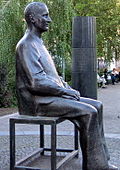- The Seven Deadly Sins (ballet chanté)
-
This article is about Weill, Brecht and Balanchine's ballet. For other uses, see Seven deadly sins (disambiguation).
The Seven Deadly Sins (German: Die sieben Todsünden,[1] French: Les sept péchés capitaux) is a satirical ballet chanté ("sung ballet") in seven scenes (nine movements) composed by Kurt Weill to a German libretto by Bertolt Brecht in 1933 under a commission from Boris Kochno and Edward James. It was translated into English by W. H. Auden and Chester Kallman. This would be the last major collaboration between Weill and Brecht.
Contents
Performance history
The Seven Deadly Sins was first performed in the Théatre des Champs-Elysées in Paris on 7 June 1933. It was produced, directed and choreographed by George Balanchine with mise en scène by Caspar Neher. The lead roles were played by Lotte Lenya (Anna I) and Tilly Losch (Anna II).[2] Nils Grosch writes that it "was met with bewilderment by the French audience (not just because the work was sung entirely in German). German émigrés living in Paris, however, were enthusiastic and considered it 'a grand evening.'"[3] The production went to London opening at the Savoy Theatre under the title Anna-Anna, on 28 June of the same year with an impromptu translation by Lenya.
Kurt Weill was commissioned to compose Die sieben Todsünden by Edward James, a wealthy Englishman who had been in Paris during Weill’s visit in December of 1932. James’s wife, Tilly Losch, was a ballerina who James himself described as having a striking resemblance to Weill’s wife, Lotte Lenya.[4] Knowing that Weill was going to write for Lenya, James, in contracting Weill for the opera, included a clause for his wife, Losch, to dance opposite her lookalike.[5] This set-in-stone the complicated split personality plot before Bertolt Brecht even knew he was the librettist.
It was revived by Weill's widow Lenya in the 1950s; however with the main singing part in version transposed to a fourth below its original pitch level which matched her new lower voice but did not correspond to his intentions.[6] Another transposed version, down by a full octave, was used by Marianne Faithfull in her recording from 1997.[6] The original higher version has been recorded by, among others, Elise Ross, Anne Sofie von Otter, Teresa Stratas and Anja Silja.
Patti LuPone sang the role of Anna in a new version of the ballet, produced by New York City Ballet in May 2011. The production was directed and choreographed by Lynne Taylor-Corbett.[7]
Major productions with premiere dates
- in German unless otherwise noted
- June 7, 1933, Paris, Théâtre des Champs-Elysées; George Balanchine, choreographer; Maurice Abravanel, conductor.[8]
- December 4, 1958, City Center, New York City Ballet; George Balanchine, choreographer; Robert Irving, conductor; Anna I (singer), Lotte Lenya; Anna II (dancer), Allegra Kent (in English).[9][10]
- June 15, 1976, Wuppertal, Wuppertaler Tanzwoche; Pina Bausch, choreographer; Frank Meiswinkel, conductor.
- December 23, 1987, Lyon, Lyon Opéra-Ballet; Maguy Marin, choreographer; Kent Nagano, conductor.
- March 15, 1997, New York State Theater, City Opera, Anne Bogart, director, Derrick Inouye, conductor.[11]
- April 26, 2007, London, Royal Ballet; Martha Wainwright, Zenaida Yanowsky, Marianela Núñez; director / choreographer Will Tuckett; Martin Yates conductor.
Roles
Role Voice type Premiere Cast,
(Conductor:)Anna I soprano Lotte Lenya Anna II dancer Tilly Losch Brother baritone Albert Peters Mother bass Heinrich Gretler Father first tenor Otto Pasetti Brother second tenor Erich Ruchs Synopsis
 The Seven Deadly Sins in the recording with Lotte Lenya
The Seven Deadly Sins in the recording with Lotte Lenya
The Seven Deadly Sins tells the story of two sisters, Anna I and Anna II. Anna I, the singer, is the main singing voice. Her sister Anna II, the dancer, is heard only infrequently and the lyrics hint at the possibility that they are the same person: "To convey the ambivalence inherent in the 'sinner', Brecht splits the personality of Anna into Anna I, the cynical impresario with a practical sense and conscience, and Anna II, the emotional, impulsive, artistic beauty, the salable product with an all too human heart."[12]
"The Family", a male quartet, acts as the Greek chorus. Both sisters set out from the banks of the Mississippi in Louisiana to find their fortune in the big cities, and to send enough money back to their family to build a little house on the river. After the prologue, in which Anna I introduces the sisters and their plans, seven scenes are devoted to the seven deadly sins, each encountered in a different American city:
- Prologue
- Faulheit / Sloth (city not mentioned)
- Stolz / Pride (Memphis)
- Zorn / Wrath (Los Angeles)
- Völlerei / Gluttony (Philadelphia)
- Unzucht / Lust (Boston)
- Habsucht / Greed (Tennessee, in posthumous versions Baltimore)
- Neid / Envy (San Francisco)
- Epilogue (home, in the new little house)
After arriving back home after seven years, the sisters ostensibly succeed in securing the means to buy the little house, but in the process Anna II envies all those who can engage in the sins she has been deprived of, and the epilogue ends in a sober mood, with Anna II's resigned response to her sister, "Yes, Anna."
Origins
The origins of Weill’s one-act opera, which premiered on June 7, 1933, came from the events of the previous February. With the Nazis seizing power, the Reichstag fire of February 28 was all that was needed for the librettist and composer, especially Weill as a Jew, to see that Berlin was no longer going to be conducive to their artistic development. After spending time in Paris in December of 1932, Weill quickly moved back, with his money still held by soon-to-be Nazis in German banks, and found work soon after.[13] Brecht, on the other hand, took the more circuitous route to Paris. He left Paris for Prague, had only a short stay, and went to Vienna to live with a friend. In less than a month he was already in Zurich, and then to a cheaper residence in Lugano, Switzerland. In Lugano he met a patron that offered him residence in his summer home in Carona, outside Lugano. Upon arriving at his sixth residence in as many weeks Brecht received word from Weill of his commission for the Seven Deadly Sins and made the journey to Paris. Seven cities in seven weeks.[14] Each of the seven scenes takes place approximately one year after the previous and Anna find herself in a new city each time. It is this geographical journey that is parallel to the journey that Brecht takes, his trek from Berlin to Paris.
Satire
The full title (in English) is "The Seven Deadly Sins of the Petty Bourgeousie". The libretto is satirical: the important moral point is that Anna II does wrong only when she does not commit the sin concerned. Anna II frequently tries to do the right thing, but is cured of this "temptation" to "sin" by her hypocritical family and her "prudent" alter ego. For instance, her "pride" consists in not wanting to work in a strip club, her "lust" is wanting to marry the one she loves rather than marrying for money, and her "anger" is righteous anger against ill-treatment of a fellow worker.
Recordings
- Lotte Lenya sings Kurt Weill's The Seven Deadly Sins & Berlin Theatre Songs (Sony 1997)
- Die sieben Todsünden; Chansons B.Fassbaender, Radio-Philharmonie Hannover des NDR, C.Garben (HMA 1951420)
- Die sieben Todsünden. (The Seven Deadly Sins). Gisela May; Rundfunk-Sinfonieorchester Leipzig; Herbert Kegel, cond. Polydor 429 333-2.; Deutsche Grammophon 139308
- Die sieben Todsünden (The Seven Deadly Sins). Songs. Marianne Faithfull, Vienna Radio Symphony Orchestra, Dennis Russell Davies, cond. Sung in English. Reverso/RCA Victor 74321 601192. (Reissued 2004 as RCA Red Seal 82876-60872-2.)
References
- ^ Sometimes listed as Die sieben Todsünden der Kleinbürger ("The Seven Deadly Sins of the Petty Bourgeoisie").
- ^ Jurgen Schebera: Kurt Weill: An Illustrated Life; New Haven, Conn.: Yale University Press, 1997 (ISBN 0-300-07284-8).
- ^ Nils Grosch, album notes, Weill, The Seven Deadly Sins, Marianne Faithfull / Vienna Radio Symphony Orchestra (BMG Classics 2004 CD 82876060872-2, reissue of 1997 recording)
- ^ Ronald K. Shull, “A New Orpheus,” The Genesis of Die sieben Todsünden, comp. Kim H. Kowalke (New Haven: Yale University Press, 1986), 206.
- ^ Jurgen Schebera: Kurt Weill: An Illustrated Life; New Haven, Conn.: Yale University Press, 1997 (ISBN 0-300-07284-8).
- ^ a b Nils Grosch, Joachim Lucchesi, Jürgen Schebera: Kurt Weill-Studien; Stuttgart: M & P Verlag für Wissenschaft und Forschung, 1996 (ISBN 3-476-45166-6).
- ^ Jones, Kenneth."Patti LuPone To Sing Seven Deadly Sins, Susan Stroman Creates Ellington Piece for NY City Ballet" playbill.com, December 27, 2010
- ^ George Balanchine Foundation webpage for Les Sept Péchés Capitaux, 1933, per Boris Kochno
- ^ George Balanchine Foundation webpage for The Seven Deadly Sins, 1958
- ^ NYCB webpage for The Seven Deadly Sins, 1933 and 1958
- ^ Die sieben Todsünden (1933), Kurt Weill Foundation. Accessed 15 November 2006.
- ^ Steven Paul Scher, Walter Bernhart, Werner Wolf: Essays on Literature and Music (1967-2004), Rodopi, 2004. (ISBN 90-420-1752-X)
- ^ Ronald K. Shull, “A New Orpheus,” The Genesis of Die sieben Todsünden, comp. Kim H. Kowalke (New Haven: Yale University Press, 1986)
- ^ Ronald K. Shull, “A New Orpheus,” The Genesis of Die sieben Todsünden, comp. Kim H. Kowalke (New Haven: Yale University Press, 1986)
External links
- Amadeus Almanac, accessed 26 October 2008
- The Seven Deadly Sins on the site of the Los Angeles Philharmonic Association
Works for the stage by Kurt Weill Der Protagonist (1926) · Mahagonny-Songspiel (1927) · Der Zar lässt sich photographieren (1928) · The Threepenny Opera (1928) · Happy End (1929) · Der Lindberghflug (1929) · Rise and Fall of the City of Mahagonny (1930) · Der Jasager (1930) · Die Bürgschaft (1932) · Der Silbersee (1933) · The Seven Deadly Sins (1933) · Der Kuhhandel (1935) · Johnny Johnson (1936) · The Eternal Road (1937) · Knickerbocker Holiday (1938) · Lady in the Dark (1940) · One Touch of Venus (1943) · The Firebrand of Florence (1945) · Street Scene (1946) · Down in the Valley (1948) · Love Life (1948) · Lost in the Stars (1949)Categories:- Operas by Kurt Weill
- German-language operas
- Operas
- One-act operas
- 1933 operas
- Plays by Bertold Brecht
- Ballets by George Balanchine
- 1933 ballet premieres
- New York City Ballet repertory
- Operas set in the United States
Wikimedia Foundation. 2010.

